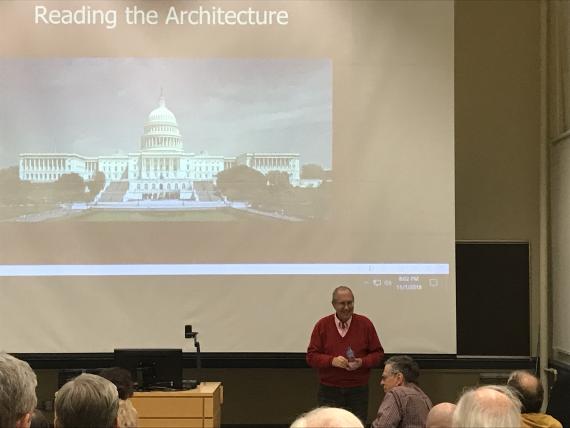By Bret Windhauser
On November 7, 2018, History Department Emeritus Professor Jere Bacharach presented his research on Islamic Cairo and its developments over time in the second ARCE lecture of the 2018-2019 academic year. Attendees were invited to listen to Prof. Bacharach’s findings on the development of the Cairo’s Architecture as a study for built environments in the wider Near and Middle East. Specifically, Prof. Bacharach explored the balance of power between the rulers of a place and the general populations at different stages of history. With photographs from the region, Prof. Bacharach teaches the audience how “Reading the Architecture of Power” shines light on historical power structures in society.
Prof. Bacharach explored the balance of power between the rulers of a place and the general populations at different stages of history
These power structures found at certain points in history naturally affected the landscapes of their localities. Creating modern Cairo was a process of changing architectural traditions and power structures. Transitioning from Fustat to al-Askar to al-Qata’I and finally to Cairo, Prof. Bacharach compacted around 1,400 years of history into his one hour lecture. In doing so, the lecture expanded on magnificent Islamic architecture in Cairo from the Mosque of Amr ibn al-‘As and the Mosque of Ahmad ibn Tulun, up to the 19th century Mosque of Muhammad Ali. While religious architecture is one method of showing prestige and wealth in a society, power is expressed through governmental structures.
From the mid 7th century until the modern day, Prof. Bacharach claims there are five periods of governmental architectural styles which dominated in the Near East. From Dar al-‘Imarahs to palaces, citadels to modern and new cities, elites in society solidified their power through visual representations of governance. Architecture, like literature and language, changes fashion. Such changes can be out of necessity as in cases when an empire is experiencing internal tension, the architectural form demonstrating power might be located away from large population centers for protection. These architectural styles are also influenced by other trends in beauty or adapt to foreign visual languages as is the case when Khedive Isma’il (1863-1879) initiated building projects in Cairo to replicate Western European standards. Through Cairo’s history, the architectural styles which communicate power and prestige have changed style. The nature of these changes explain historical developments and trends throughout the Near East and the wider world.
The next ARCE lecture in the series will be Dr. Katherine Law leading an interactive session on Exploring Egyptology Through Technology on January 17, 2019.
Bret Windhauser is a first year MA student at NELC. He focuses on identity formation in refugee and migrant communities. NELC is a proud supporter of ARCE Lecture Series.
